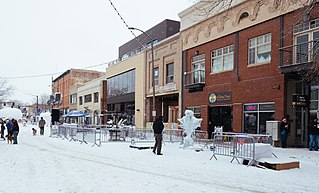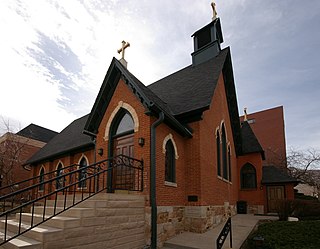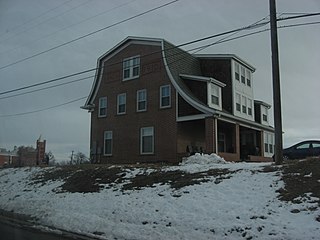
The City of Loveland is the Home Rule Municipality that is the second most populous municipality in Larimer County, Colorado, United States. Loveland is situated 46 miles (74 km) north of the Colorado State Capitol in Denver and is the 14th most populous city in Colorado. As of the 2010 census the population of Loveland was 66,859, and in 2019 the population was estimated at 78,877. The city forms part of the Fort Collins-Loveland Metropolitan Statistical Area and the Front Range Urban Corridor. The city's public schools are part of the Thompson R2-J School District.

William Austin Hamilton Loveland was a U.S. railroad entrepreneur and businessman in the late 19th century. An early resident of Golden when it was the capital of the Colorado Territory, he was one of the founders of the Colorado Central Railroad and a principal figure in the early history of Colorado. As president of the Colorado Central, he was instrumental in the expansion of the railroad network into the mining communities of Colorado. For much of the 1870s Loveland waged a fierce struggle with Union Pacific investors for control of the Colorado Central. He also served as Lieutenant Governor of Colorado.

Natchez National Historical Park commemorates the history of Natchez, Mississippi, and is managed by the National Park Service.

Calvary Episcopal Church is a Gothic Revival style chapel dating to the pioneer days of Golden, Colorado, United States. It is the oldest continuously used Episcopal church in Colorado, and is listed on the National Register of Historic Places.

The Loveland Block and the Coors Building are adjacent historic storefront buildings in downtown Golden, Colorado. The Loveland Block, named for pioneer William A.H. Loveland, once served as the territorial capitol building of Colorado. Both buildings are listed on the National Register of Historic Places as a single entity.

The Barnes–Peery House, known commonly as the Barnes Mansion, is one of the oldest private homes of Jefferson County, Colorado, USA. It was built in 1865 by David Barnes, the first flour miller in Jefferson County, who had just moved his flouring mill to Golden after establishing it on Bear Creek to the south the year before. The Barnes home was the first major brick house in Jefferson County, and is designed in Italianate style, featuring rows of stone arched windows. A rear carriage house was built in 1871. While living here Barnes founded Loveland, Colorado, in 1873. After surviving a fire that destroyed its roof in 1875, the home went on to house other owners of the flour mill, including the Peery family who operated the business for much of the 20th century.

The First Presbyterian Church of Golden and the Unger House are two buildings in the Foothills Art Center in Golden, Colorado, United States. Together with a manse adjourning the church they were listed on the National Register of Historic Places in 1991, and are the most prominent landmarks of Golden's Court House Hill neighborhood.

The William H. McGuffey House is a historic house museum at 401 East Spring Street, on the campus of Miami University in Oxford, Ohio, United States. Built in 1833, it was the home of author and professor William Holmes McGuffey (1800-1873) from then until 1836. It is believed to be the site where he wrote the first four of the McGuffey Readers, widely popular instructional texts used to educate generations of Americans. The house was designated a National Historic Landmark in 1965. It is now operated by Miami University as the William Holmes McGuffey Museum.

The Charles H. Stickney House in Pueblo, Colorado, USA, was built in 1890. It was designed by New York architect William Halsey Wood, and Pueblo architect Frederick Albert Hale supervised its construction.

The William J. Gregory House is a historic house located at 8140 Lowell Boulevard in Westminster, Colorado. It was listed on the National Register of Historic Places in 1996.

Montezuma Fuller (1858–1925) was an American architect. He was the "most notable architect in the late nineteenth and early twentieth centuries" of Fort Collins, Colorado.

The First United Presbyterian Church at 400 E. 4th St. in Loveland, Colorado was built in 1906. It was designed by architect Montezuma Fuller. It was listed on the National Register of Historic Places in 2004.
Four historic bridges on the Big Thompson River in Larimer County, Colorado survived its flood of 1976, but since have lost most of their historic integrity. They were built in 1933 and 1937. All four were listed on the National Register of Historic Places in 2002, and two were delisted in 2010.

Midwest Steel & Iron Works was a metal fabrication company based in Denver, Colorado. Founded in 1893, the company was known for a time as the Jackson-Richter Iron Works. The company was one of the "oldest and largest metal fabricators" in Denver. The company built both structural and ornamental components for structures throughout Colorado, Wyoming and New Mexico. The company's headquarters on Larimer Street in Denver includes an Art Deco office building and consists of a four-building complex that is itself considered a historic industrial site. The complex served as the company's headquarters from 1923 to 1983.
Frederick Albert Hale was an American architect who practiced in states including Colorado, Utah, and Wyoming. According to a 1977 NRHP nomination for the Keith-O'Brien Building in Salt Lake City, "Hale worked mostly in the classical styles and seemed equally adept at Beaux-Arts Classicism, Neo-Classical Revival or Georgian Revival." He also employed Shingle and Queen Anne styles for several residential structures. A number of his works are listed on the U.S. National Register of Historic Places.

The John Daniel Rather House is a historic residence in Tuscumbia, Alabama. The house was built in 1823 by William H. and Catherine Winter, who came to The Shoals from Prince William County, Virginia. It was taken over by the Union Army during the Civil War and used as the headquarters of General Florence M. Cornyn. After the war, the house was purchased by John Taylor Rather, an early North Alabama settler who was deputy sheriff of Madison County, and a longtime member of the Alabama House of Representatives and later the Alabama Senate. His son, John Daniel Rather, also served in both houses of the state legislature, and was President of the Memphis and Charleston Railroad.

Doyle Settlement was a ranch and settlement in Pueblo, Pueblo County, Colorado. It was listed on the National Register of Historic Places on April 4, 1980.


















